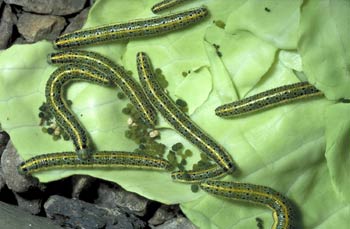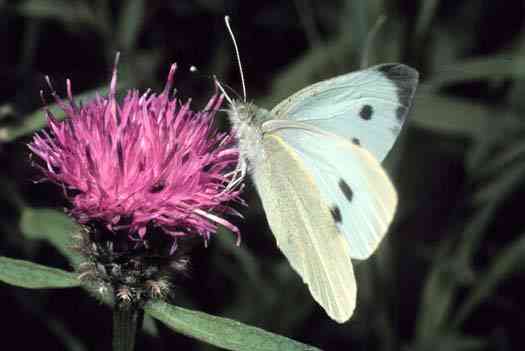Cabbage Butterfly
The Cabbage Butterfly, also known as the Cabbage White or simply the Large White is one of the most widespread butterflies in Europe. They are not, however, welcome guests in gardens, because the butterfly’s caterpillars feast on a variety of cabbage species. This species is common in all parts of Europe less than 2000 metres above sea level, and there are also populations in northern Africa, as well as some parts of Asia.
In size, the mature individuals (imago) are no larger than most butterflies, reaching a wingspan of 56-68 mm. Their appearance is also not very spectacular, with males being completely white, while the females have a few dark spots on the wings. The caterpillar, however, is relatively large, reaching a size of up to 50 mm, and it is coloured yellowish green, covered in black spots.
The life cycle of this species begins when the caterpillar breaks out from the egg. It immediately starts feeding on the plant upon which it has hatched – a cruciferae plant, most usually cabbage, cauliflower or mustard growths. About 20 days later the caterpillar finds a secluded place and creates a cocoon, where it undergoes a full metamorphosis, evolving into a grown individual – imago. This transformation takes about 20 days, and after emerging from the cocoon, the butterfly lives for 1-2 months.
The mature Cabbage Butterflies soon start looking for a mating partner. Females have a special scent that can attract males from a distance of up to 100 metres. After copulation, the female starts looking for a place to lay eggs – most usually the leaves of a cruciferae plant. The female lays 50-100 yellow eggs, from which the caterpillars hatch in 10-15 days, and the cycle begins again.
From the moment of hatching until creating a cocoon, the caterpillar feeds without stopping. Gardeners and farmers dislike the Cabbage Whites, because they can completely destroy a harvest. The caterpillars are protected from a lot of predators by the bright colour, as well as a very unpleasant scent. If there is a threat, the caterpillar curls up in a small ball and falls on the ground. There are, however, some that still hunt them, or even worse – some species of wasps pierce the caterpillar with their sting and lay eggs inside its body. Upon hatching, the wasp’s larvae eat the caterpillar from the inside.
Mature Cabbage Butterflies feed on the nectar of a variety of sweet flowers. Special receptors help the butterfly find appropriate flowers, after which the animal sucks the nectar out with the straw-like snout. The imagoes are completely harmless to gardens, except for the fact that they can and will lay more eggs on plants.
Cabbage Butterflies are widespread around almost all parts of Europe and in all places of their natural habitat, they are seen in large numbers. Still, with the usage of pesticides, the numbers of Cabbage Butterflies have been decreased over the last few decades, but they are not in threat of extinction.





How can something so ugly transform into something so beautiful? http://jennifercisowski.blogspot.com
she is botonlla